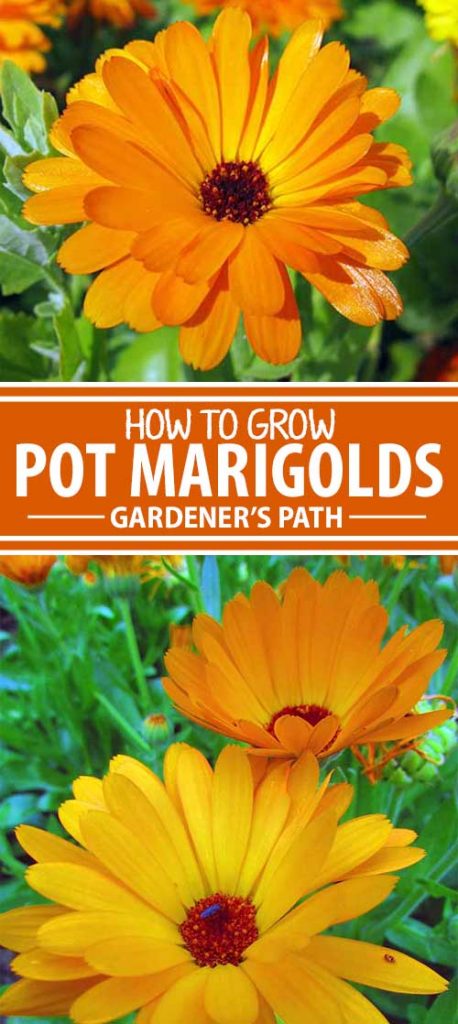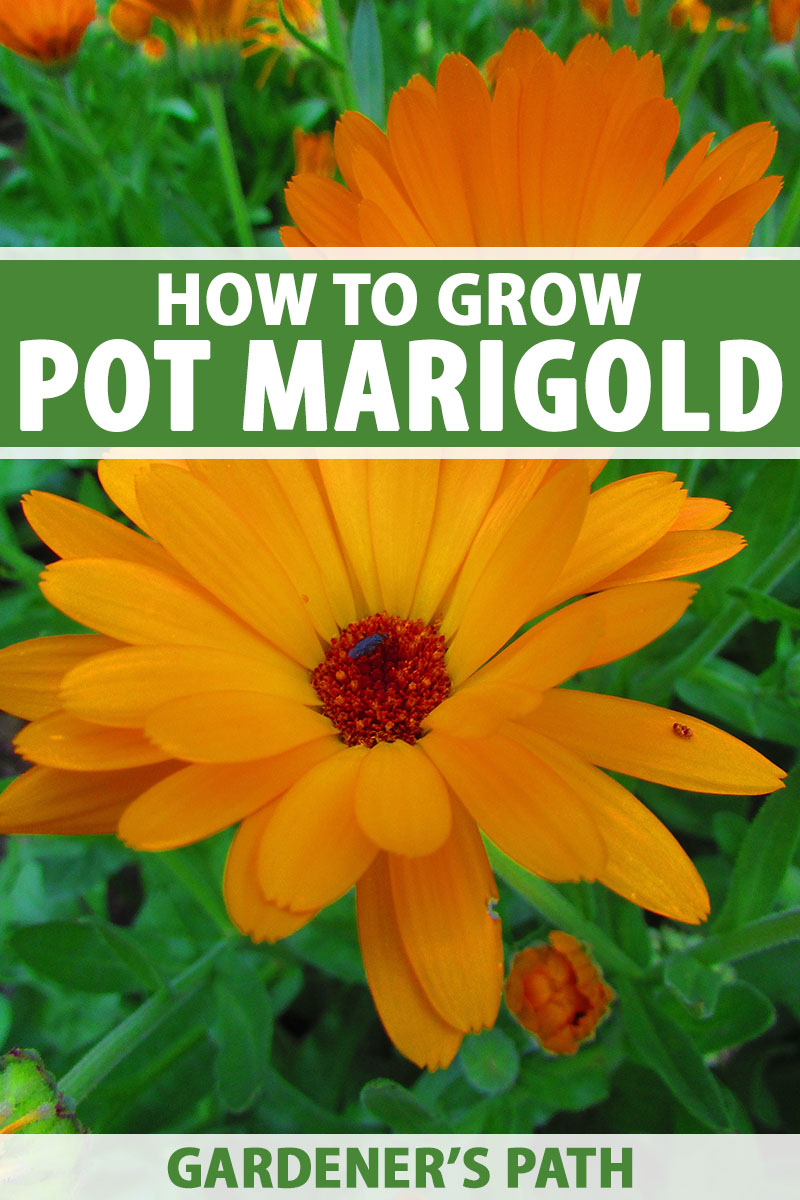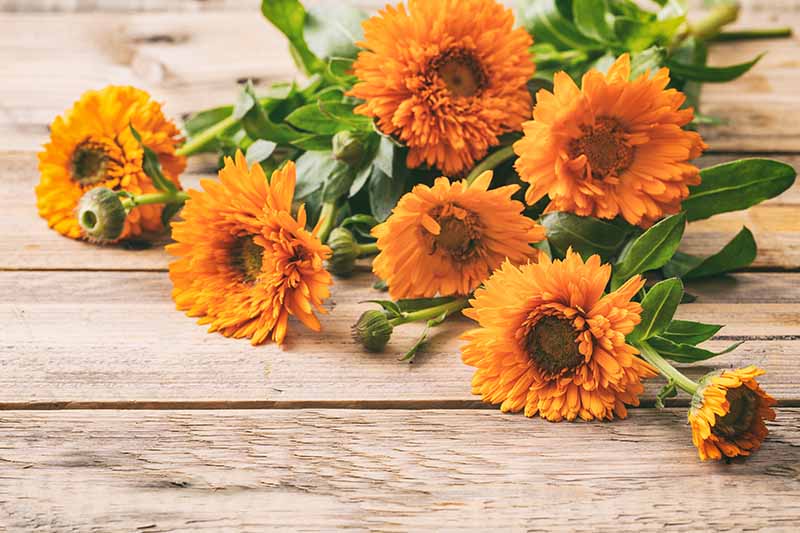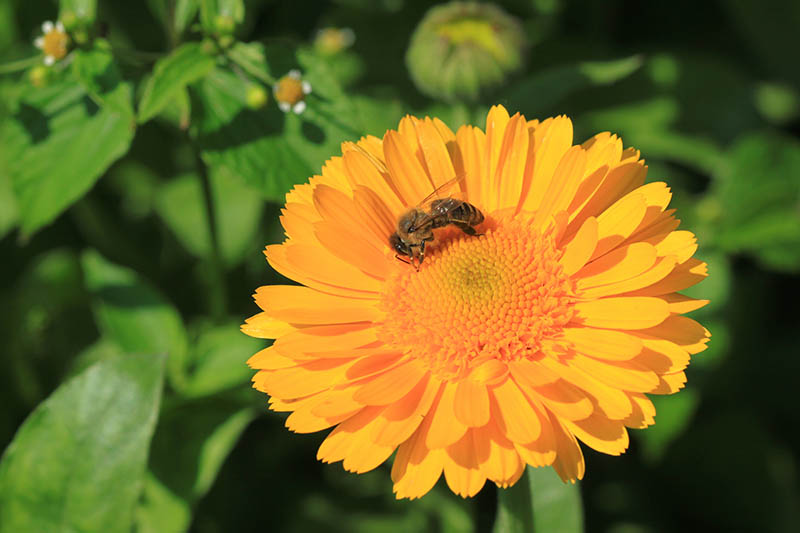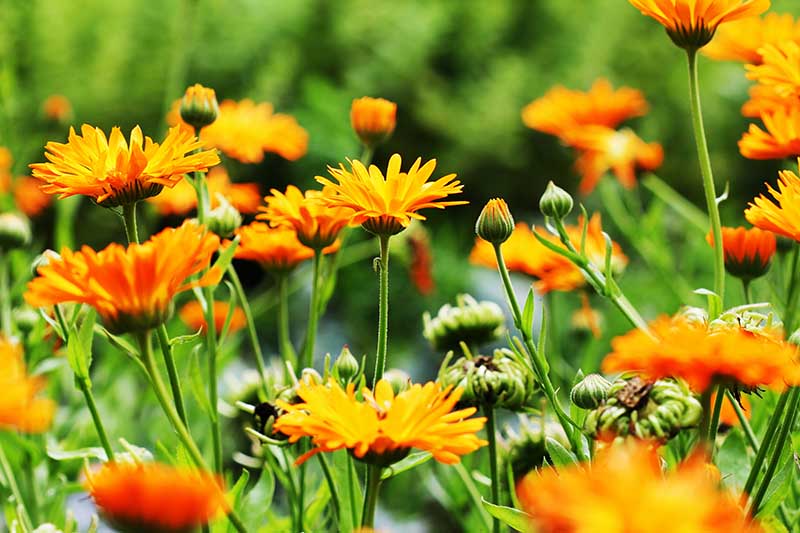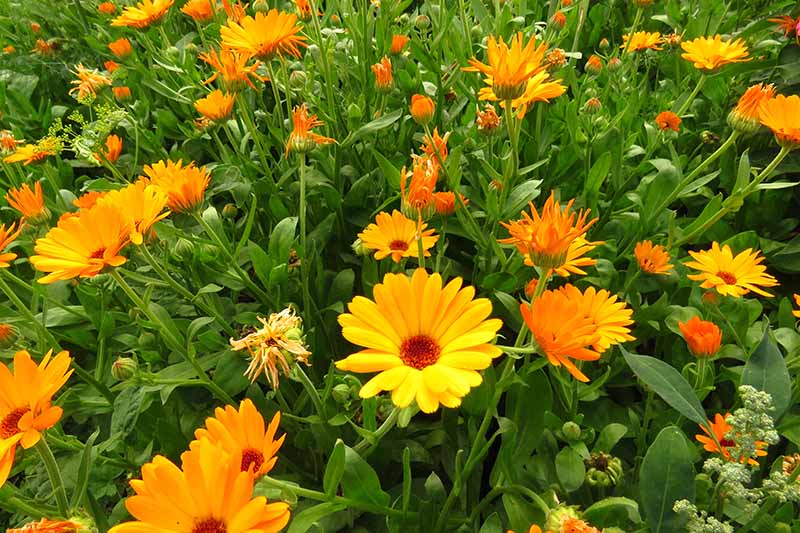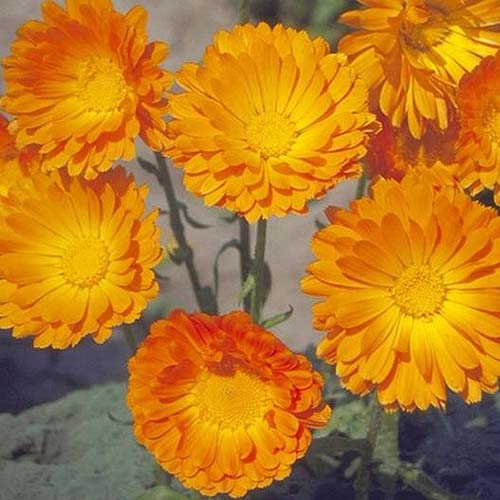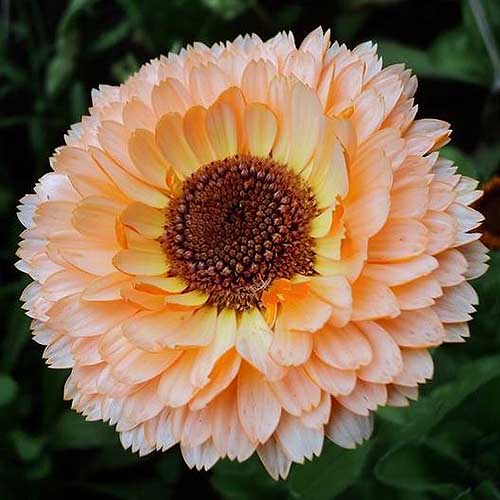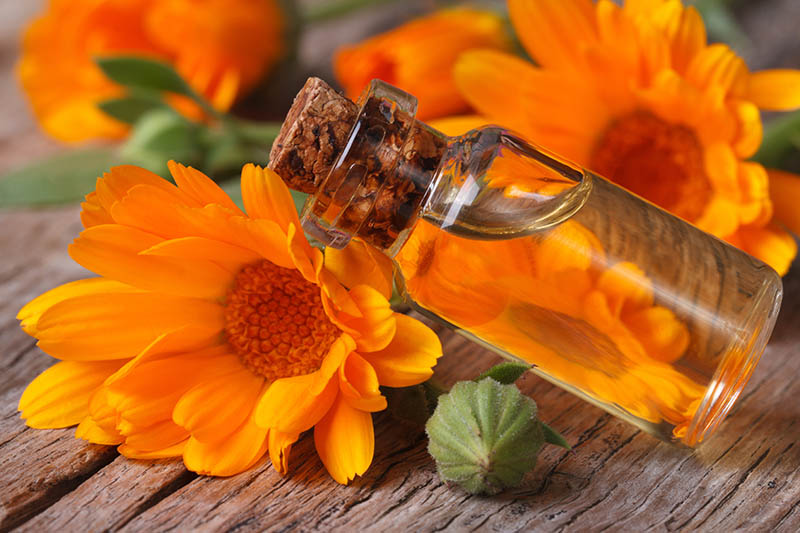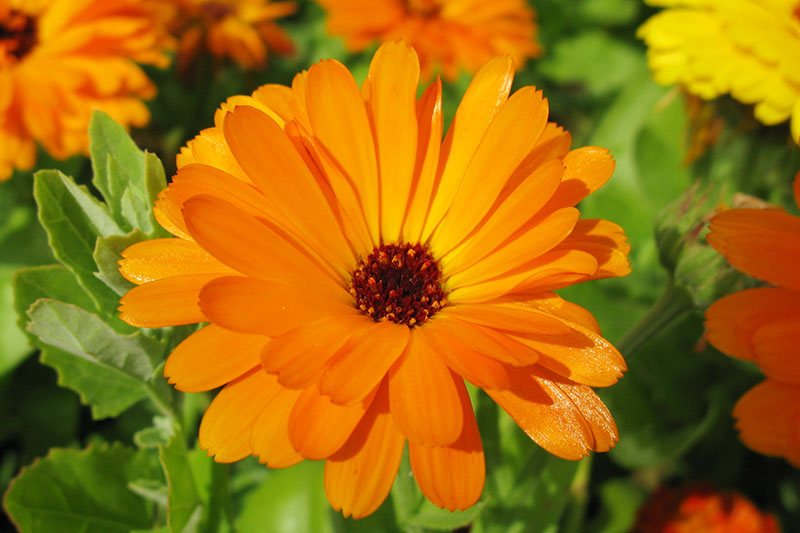Each day I am pleasantly surprised to see a collection of new buds developing on my plants. An herb that keeps on giving, the showy flowers of calendula bloom well into the fall. We link to vendors to help you find relevant products. If you buy from one of our links, we may earn a commission.
What Is Calendula?
Pot marigold, Calendula officinalis, also known as calendula or English marigold, is a member of the Asteraceae family, which includes asters, chrysanthemums, sunflowers, and true marigolds.
The blossoms of C. officinalis resemble the true marigold flowers of the Tagetes genus which includes the French marigold, T. patula, and the Mexican (sometimes called African) marigold, T. erecta. In spite of the common name “pot marigold” C. officinalis is not a true marigold. This annual herb can grow up to 24 inches tall, depending on the variety, and produces vibrant flowers in shades of orange, yellow, or peachy-pink that bloom from early summer through fall.
They brighten up beds and borders, add a pop of color to containers, and are a beautiful addition to cut flower arrangements or bouquets. Suitable for gardeners in USDA Hardiness Zones 2-11, pot marigold is easy to grow, and the blooms attract pollinators like bees, and other beneficial insects.
Cultivation and History
C. officinalis is native to the Mediterranean region, north Africa, and parts of the Middle East.
In medieval Europe, it was known as “poor man’s saffron,” and was used to add flavor and color to soups and stews. The flowers were blended into soothing salves and stirred into restorative elixirs. Estimates place its introduction to the United States at the time of the European settlers’ arrival in the 1600s. During the civil war, many doctors carried dried calendula flowers in their medical bags to stop bleeding and help wounds heal. In addition, this plant is a well-respected “beneficial botanical,” with culinary and medicinal uses. C. officinalis is on the FDA List of Substances Generally Recognized as Safe, and scientists from around the world have conducted extensive studies, describing its properties as “bioactive and free radical scavenging” and “protective and cytotoxic.”
The flowers contain anti-inflammatory triterpenes and antioxidant flavonoids and are widely used in herbal remedies. They can be infused in oil or in creams and applied topically to wounds and other skin complaints. Often used to help prevent infection and speed up the healing process, calendula creams and ointments can be applied to everything from burns to cuts, acne to diaper rash. Dried or fresh flowers can also be made into a soothing tea to alleviate the symptoms of colds and flu. The flowers have a peppery, slightly tangy flavor, and can be sprinkled on soups and stews, or added to salads for a vibrant pop of color. Pot marigold’s bright orange pigment can also be used to dye fabric.
Propagation
If you’re looking for a flower that makes a colorful splash in the garden from spring through summer and well into fall, this is the plant for you.
C. officinalis is easy to propagate from seed, or you can pick up nursery starts at your local garden center, to get a jump on the growing season.
From Seed
Pot marigold can be sown directly in the garden in spring after the last frost has passed. Gardeners in Zones 7-11 can sow seeds in fall. Prepare a garden bed by clearing away debris and adding some fresh compost, and then either broadcast seeds or create rows, planting every six inches. Cover the seeds with 1/4 to 1/2 inch of soil, tamp down gently, and water thoroughly. Seeds should germinate within a week. You can thin the seedlings when they have one or two sets of true leaves.
From Seedlings or Transplants
I like to start seeds indoors, so my C. officinalis cultivation is usually underway by late March, in Zone 5. You can start seeds six to eight weeks before last frost. Prepare seed trays or small containers with a well-draining potting soil and sow 1/4-inch deep. Keep them moist but not waterlogged until germination. When all danger of frost has passed, and seedlings have at least two sets of true leaves, harden them off by placing them outdoors in a sheltered location for an hour or so per day, gradually increasing the time over the course of a week. After hardening off, transplant the seedlings or nursery starts outdoors, six to 12 inches apart in a garden bed amended with compost. Keep transplants moist and weed-free until well established.
How to Grow
Calendula grows best in filtered sun or part shade, and tends to thrive in cooler temperatures. In warmer areas, be sure to plant it where it will receive some shade in the hottest part of the day – or grow it in pots that you can move around.
Plants prefer organically-rich soil, but will tolerate most soil types, provided it is well-draining. Keep soil evenly moist, but be careful not to overwater, as they do not like wet feet. Established plants will tolerate some dry spells. In hot regions, you can apply a layer of mulch around the base of your plants to help retain moisture and keep the soil cool. As the plants grow, pinch back leggy stems to encourage a bushy growth habit, and deadhead spent blossoms to ensure a continuous display of color throughout the growing season.
Pot marigold is an annual that self-sows readily, so if you don’t deadhead the flowers and your climate is accommodating, you may find that it behaves like a perennial – coming back year after year. If you want your plants to self-sow, remove spent blossoms sporadically, or not at all, to allow seed to form and scatter naturally. If you prefer to grow your C. officinalis in containers, select a pot that’s at least six inches deep, with drainage holes in the bottom. Allow six inches between plants, if you are growing more than one, or use multiple pots. Use a good quality, well-draining potting soil, and remember that containers dry out quicker than garden soil, so you may need to water more frequently.
Growing Tips
Plant in organically-rich, well-draining soil. Choose a location with filtered sun or part shade. Deadhead blooms to encourage continual flowering.
They are often planted to deter pests from other plants as they attract beneficial insects such as parasitic wasps and hoverflies.
Ball’s Improved Orange
This popular heirloom cultivar boasts vibrant orange, double blooms up to three inches across.
‘Ball’s Improved Orange’ Plants reach a mature height of 12 to 24 inches, and will provide a bright splash of color to your borders or in cut flower arrangements. Packets of seeds are available from Eden Brothers.
Bon Bon
This dwarf variety is an early-blooming, vigorous grower and produces brilliant two to three-inch golden fully-double blooms, that resemble pompoms.
‘Bon Bon’ Choose from orange, yellow, or mixed colors. Mature height is just 12 inches, making this dwarf variety the perfect choice for containers or garden beds. ‘Bon Bon’ seeds are available from True Leaf Market.
Pink Sunrise
‘Pink Sunrise’ is a dwarf cultivar that grows to a mature height of nine to 12 inches tall, with two to three-inch double-petalled blooms.
‘Pink Sunrise’ The gorgeous peachy-pink, ruffled blooms have a deep orange underside, and are a delightful addition to cut flower arrangements or bouquets. Seeds are available from Eden Brothers.
Managing Pests and Disease
Pot marigolds rarely experience problems with pests and disease.
Insects
That said, you may occasionally see these pests on or around your plants:
Aphids
Aphids are tiny little sap sucking insects that feed on leaves. Infestations can cause leaf curl and yellowing of foliage. Aphids also produce a sap called honeydew which can attract ants and encourage sooty mold. A strong blast from the hose can dislodge the aphids or you can spray with neem oil. Learn more about managing aphids in your garden here.
Slugs
These slithery little pests leave behind a trail of slime as they eat large holes through foliage. When left to their own devices, they can even eat entire leaves. Mostly a problem in wet weather, slugs can be hand picked in the evening. You can also use beer traps to catch them. Just dig a cup sized hole and place a cup half filled with beer inside to lure the slugs. Diatomaceous earth can also be sprinkled around the base of plants to deter slugs. Learn more about how to manage slugs and snails in your garden here.
Whiteflies
These small soft bodied white flies feed on the undersides of leaves. Similar to aphids, whiteflies also produce honeydew, which can encourage mold. Whiteflies can also be removed with a strong blast of water from a hose. If an infestation becomes serious, you can also spray a homemade insecticidal soap of water mixed with a few drops of dish soap or use neem oil. Read more about combating whitefly infestations. Get a comprehensive list of calendula pests and control measures here.
Disease
Pot marigold isn’t prone to disease, but there are couple that can cause problems. The main issues you may face include:
Aster yellows
This disease is caused by an organism called a Phytoplasma and is spread by leafhoppers. It causes stunted leaves and flowers, and ultimately leads to the death of your plant. Floating row covers or light colored mulches can discourage leafhoppers and reduce the spread of this disease. There is no cure for aster yellows, so remove and destroy infected plants, do not place them on the compost pile. You can earn more about aster yellows in this guide.
Calendula Smut
This fungal disease, caused by Entyloma calendulae, affects leaves, creating yellow, brown, and black spots with dark borders. The thick lesions can be seen on both sides of the foliage. Water at the base of plants to prevent excess moisture on the flowers and foliage, and remove debris at the end of the growing season to help reduce the risk of fungal spores overwintering in dead plant matter.
Powdery mildew
This fungal disease primarily affects plants in humid weather, and causes a white or grey coating to appear on the surface of leaves, and may cause foliage to curl. Maintain proper spacing between plants to encourage good air circulation, and prune infected foliage. Homemade sprays made with vinegar, dish soap and baking soda, or milk can sometimes be effective at controlling powdery mildew on plants.
Harvesting and Preserving
Flowers can be picked continually throughout the season. You can harvest whole flower heads for use in herbal preparations that soothe and heal, for a refreshing tea, or to use as a tangy garnish.
In midmorning or early afternoon after the dew has dried and flowers are fully open, cut or pluck the flower heads. If you are not using them immediately, individual petals may be separated, dried, and stored in an airtight container in a dry location. To dry the petals, spread them on a screen and place in them in a dark, dry location for a few days. Improperly stored flowers are prone to molding or bleaching. Before use, inspect petals closely for any signs mold, which may develop as the result of moisture buildup, and discard any that are affected.
You can also preserve your flower petals in oil. To make a calendula-infused oil, chop the dried flowers into small pieces and place in a jar. Cover with olive oil or any carrier oil you prefer, and make sure the flowers are completely submerged. Place a lid on the jar and store in a dark pantry for four to six weeks, shaking daily. Strain out the flowers and enjoy the oil in cooking, as a massage oil, or use in recipes for herbal salves and creams. See our guide to making and using calendula oil for more tips.
Recipe Ideas
The petals can be enjoyed raw or cooked and can be used to add color and flavor to any meal.
Sprinkle as a garnish atop salads, cold drinks, or on poultry. Add the flowers to wraps, cook some into your next quiche, or blend in soups and stews. Calendula tea is deliciously warming, and especially beneficial to relieve the symptoms of lingering colds, sore throats, and infections. Mix with other herbs like echinacea for a real immune system boost! Be sure to check out our guide, “Common Uses of Calendula (Pot Marigold) Flowers,” for more ideas.
Quick Reference Growing Guide
Welcoming and Beneficial
How can you go wrong with a vigorous annual that blooms continuously all summer and into the fall? And, one with orange and yellow flowers has tremendous curb appeal.
When you plan your garden, think back to art class and the color wheel. Opposites make for striking combinations, so find a couple of cobalt blue containers, fill them with pot marigold, and prepare to be amazed! Are you growing calendula in your garden? Share your growing tips in the comments below, and feel free to share a picture! To learn more about other medicinal herbs, check out these articles next:
How to Grow Bee Balm: Bring Out the Hummingbirds! How to Grow Common Chicory How to Grow and Care for Yarrow
© Ask the Experts, LLC. ALL RIGHTS RESERVED. See our TOS for more details. Originally published on September 19, 2017. Last updated September 23, 2020. Significantly revised and expanded by Heather Buckner from an original article by Nan Schiller. Product photos via Eden Brothers and True Leaf Market. Uncredited photos: Shutterstock. With additional writing and editing by Clare Groom and Allison Sidhu. The staff at Gardener’s Path are not medical professionals and this article should not be construed as medical advice intended to assess, diagnose, prescribe, or promise cure. Gardener’s Path and Ask the Experts, LLC assume no liability for the use or misuse of the material presented above. Always consult with a medical professional before changing your diet or using plant-based remedies or supplements for health and wellness.
